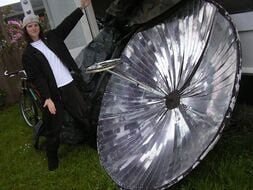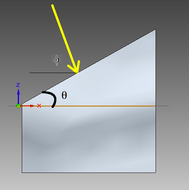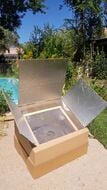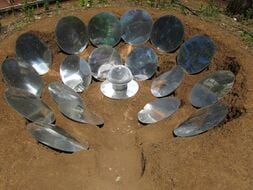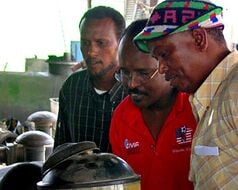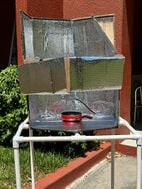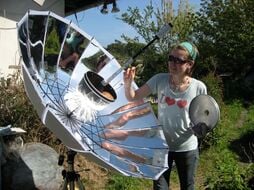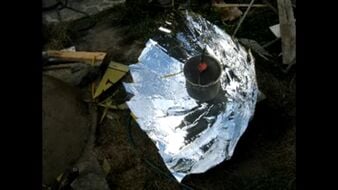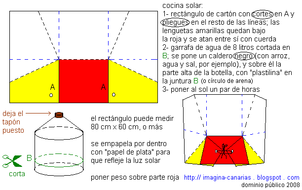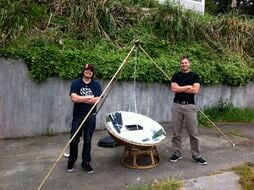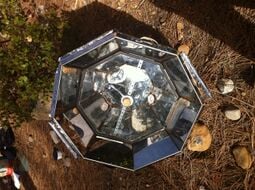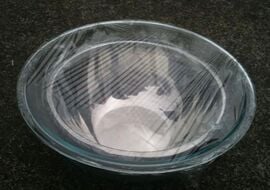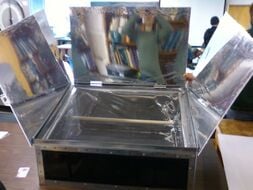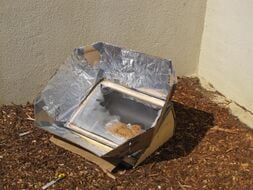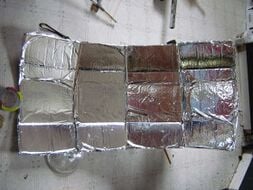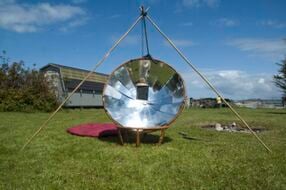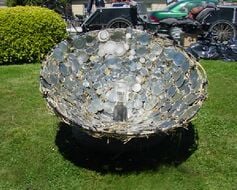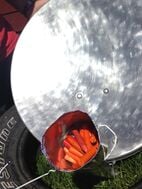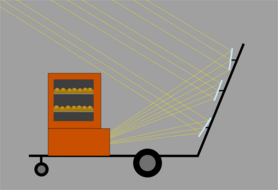
We were in Engr205 Introduction to Design and were working for Locally Delicious to design a solar oven that children ages 8-12 could build and use independently. This design took place at Cal Poly Humboldt in the United States. We were encouraged to "think out of the solar box" and create something more original than an aluminum foil covered shoe box. We wanted to get the children thinking about the food they eat and how they can be in control of their diet. After doing research on solar ovens, solar materials, the capabilities of children ages 8-12, and the transfer of heat, we came up with several alternative designs. The Solar Bowling Oven was chosen as our final design because it best meets our criteria. The Solar Bowling Oven involves two bowls placed inside each other with the inner bowl painted black on the outside. Each bowl is sealed with lids or saran wrap. The design also involves a reflector panel which is made out of a cardboard box and aluminum foil and bent into a parabolic shape. We have tested the Solar Bowling Oven with children at Arcata Elementary in which it proved to be extremely successful. When we cooked with the kids at 4pm and the weather was overcast with little sun, and the temperature was in the mid 50s, the ovens reached 150 degrees Fahrenheit after a half hour. Since the food designed to be used for this oven are foods that don't have to be cooked to be safe, we believe that this minimal temperature is appropriate. We are confident that in better weather the ovens will reach higher temperatures. The Solar Bowling Oven incorporates all the criteria asked by our client, Locally Delicious, so it would hopefully be incorporated in their new book called Lunchbox Envy.
Background[edit | edit source]
Locally Delicious is an organization founded in Humboldt, CA in the United States, by 5 women who call themselves "the heirloom tomatoes." Their goal is to motivate people to eat local foods and make healthy choices. They have been long time advocates for sustainable living, and have published their highly praised book called Locally Delicious. They are currently working on a second book called Lunchbox Envy in which its objective is to empower kids to make their own healthy food choices and teach them a sense of self empowerment. This book includes simple recipes and projects which are tasty, healthy, and easy-to-prepare. We are hoping for our design to be a part of this book.
Problem Statement and Criteria[edit | edit source]
To design a solar oven that kids ages 8-12 can build and operate on their own. The food designed to be cooked in this oven are snacks like pizza bagels.
These criteria are the standards we use for judging solutions.
Table 1: Project Criteria, Constraints, and Weights
| Criteria | Constraint | Weight |
|---|---|---|
| Cost | The at home replication cost of the materials are not to exceed $20. | 8 |
| Efficiency/ Effectiveness | The oven is to be able to cook food within a 2-3 hour time period. | 9 |
| Ease to build/use | The materials must be easy to obtain and use. | 8 |
| Aesthetics | The look of the model must be relatively pleasing to the eye. | 3 |
| Safety | The construction and handling of the oven are to not pose any health dangers or serious injuries to kids. | 10 |
| Durability | The oven should contain durable materials that produce little waste. | 7 |
| Design Creativity | The oven must be an original design. | 7 |
| Versatility | The model must be able to operate under different climates. | 8 |
Description of Final Project[edit | edit source]
The Solar Bowling Oven involves two sealed bowls with one inside of the other and a parabolic reflector. The outer bowl is glass and the inner bowl is metal and painted black on the outside. Each bowl is individually sealed with lids or saran wrap. The parabolic reflector is made out of cardboard and aluminum foil. The Solar Bowling Oven is shown in Figure 1.
Description of Components[edit | edit source]
Outer Bowl The outer-most layer of the Solar Bowling Oven is comprised of a fairly large, about 15" diameter, glass or Pyrex bowl, as seen in Figure 2. A bowl with handles is easier to work with, but not necessary. This can be purchased at most grocery stores. Glass allows light through, but since it is not a good conductor of heat, the heat is trapped inside the bowl. The heat trapped inside the bowl cooks the food.

Inner Bowl The next element to the Solar Bowling Oven is the inner bowl, which is metal, as seen in Figure 3. This is the cooking vessel and is what will be getting hot. This bowl needs to fit inside the glass bowl and have anywhere from 1/4" to 3/4" gap between the bowls. The outer glass bowl allows radiation from the sun inside and heats up the airspace between the two bowls.

Black Coating on Inner Bowl The inner bowl is covered in a black coating, as seen in Figure 4. If the inner bowl comes with a clear lid, this lid also has to be covered with the black coating. The black coating absorbs the heat within that bowl. Black barbeque or stove paint works best as the black coating since it is non-toxic when exposed to high heat. The black coating collects the radiation coming in through the glass and helps raise the ambient temperature in the airspace between the bowls.

Coverings This design works by keeping the radiation that's been captured from the sun inside the bowls. This is done by covering the inner bowl and outer bowl, as seen in Figure 5a and 5b. The coverings intensify the heat and allow the food to be cooked. The inner bowl and the outer bowl each need to be covered, so that the inner bowl with its cover is completely contained within the larger glass bowl. The ideal cover would be a lid for each, however, if that is unavailable, individually covering each bowl with saran wrap works as an alternative.

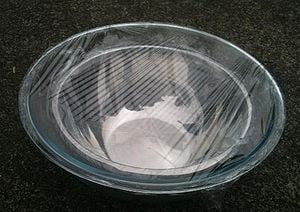
Reflector Panel A reflector panel is utilized to focus the sunlight for faster and better cooking. The reflector panel is a cardboard box propped up and bent in a parabolic shape and coated in aluminum foil, as seen in Figure 6. The cardboard box has a volume of 18"x18"x18," but box sizes that are within a half a foot of this size in each dimension will also work. The reflector panel reflects more of the sun's radiation toward the Solar Bowling Oven because the curved shape directs the radiation from different directions.

Cost[edit | edit source]
Design Hours[edit | edit source]
The design cost indicates the amount of hours that our group put into this design project. A total of 165 hours were spent on this design project and the majority of the design hours were spent in testing and implementing solution. Figure 7 shows a pie chart of the amount of hours spent on each design section.

Implementation Costs[edit | edit source]
Table 2 shows the materials and their costs for creating the Solar Bowling Oven. The retail cost of buying everything needed to create the Solar Bowling Oven is $29.94 and the amount we spent is $20.97. However, since many of the materials needed for this design can be found around the house, the projected cost is only $5.99 which is the cost of the black barbecue paint.
Table 2: Cost Table
| Material | Quantity | Retail Cost ($) | Our Cost ($) | Projected Cost ($) |
|---|---|---|---|---|
| Glass Bowl | 1 | 7.99 | 7.99 | found at home |
| Small Pot | 1 | 6.99 | 6.99 | found at home |
| Black BBQ/Stove Paint | 1 spray can | 5.99 | 5.99 | 5.99 |
| Saran Wrap | 1 roll | 1.99 | found at home | found at home |
| Aluminum Foil | 1 roll | 2.99 | 2.99 | found at home |
| Duct Tape | 1 roll | 3.99 | found at home | found at home |
| Cardboard Box | 1 | found at home | found at home | found at home |
| Total Cost: | $29.94 | $20.97 | $5.99 | |
Maintenance Costs[edit | edit source]
The Solar Bowling Oven is very durable and produces little waste. The materials are re-usable which creates a low maintenance cost. One specification for this design is that it needs to withstand at least 3 uses and all of the materials will last longer than this. The roll of saran wrap and roll of aluminum foil are the only materials that will need to be replaced, however, one roll of each will last more than 20 trials.
Testing Results[edit | edit source]
After testing the oven with kids at Arcata Elementary, we conclude that the Solar Bowling Oven is an effective design for cooking food with kids ages 8-12. The kids were having fun solar cooking and were able to create the reflector panel and Solar Bowling Oven with minimal assistance. After testing the performance of the Solar Bowling Oven in Arcata, CA with an outside temperature of 57°F, the oven reached 150°F after a half hour. More testing results can be seen in Table 3. Since the food designed to be used for this oven are foods that don't have to be cooked to be safe, this temperature is appropriate. In other areas where the outside temperature and sunlight is higher, it is reasonable to conclude that the oven will reach higher temperatures. Based on the testing results with Arcata Elementary, we can conclude that the Solar Bowling Oven design can be easily created and operated independently by kids ages 8-12.
Table 3: Results Table
| Outside Temperature | Weather Conditions | Time | Oven Temperature |
|---|---|---|---|
| 50 degrees F | No sun visible | 20 min | 90 degrees F |
| 57 degrees F | Overcast, slight sun | 18 min | 140 degrees F |
| 57 degrees F | Overcast, slight sun | 30 min | 150 degrees F |
How to Build[edit | edit source]
To see implementation instructions go to: Solarbowlingoven instructions
Instructional Video[edit | edit source]
Discussion and Next Steps[edit | edit source]
The materials for this design can be found in many households and the design itself is simple, which makes it possible for kids to recreate it. The advantages of this design are that it creates little waste, the materials can be reused many times, and the cost of creating the oven is very affordable. In addition, based on the testing results with Arcata Elementary, we can conclude that the Solar Bowling Oven design can be easily created and operated independently by kids ages 8-12. We believe that the parabolic reflector design could also be utilized by kids ages 11-15 in their math classes. Since parabolas follow the equation y=mx^2, a perfect parabolic shaped reflector could be calculated and implemented. These calculations tend to be too advanced for most kids ages 8-12, however, they are within the capabilities of kids ages 11-15.
Related projects[edit | edit source]
References[edit | edit source]
http://www.locally-delicious.org/

